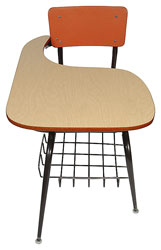 Research Highlights
Research Highlights
Key Points
- The physical environment of a classroom affects learning, behavior, and attitudes.
- Different physical arrangements are better suited for different types of tasks.
- Many classrooms environments pose ergonomic problems for students.
How Physical Environments Affect Learning
How teachers manage time and space in the classroom, often labeled proactive management, plays an important role in shaping students' behaviors (Johnson et al., 2005; Morrow, Reutzel, & Casey, 2006). "The physical arrangement of your classroom can influence the behavior and learning of your students. The placement of desks, bookshelves, pencil sharpeners, and cabinets can direct traffic flow, student interaction, noise level, attention, or disruption. The influence of the room arrangement is too important to be left to chance" (Partin, 2005, p. 2).
Physical environment affects student achievement (Dyck, 2002; Earthman, 1998; Yarbrough, 2000). Earthman's summary of research suggests that from 5 to 17 percentile points of student achievement are related to the condition of the buildings they attend. "Spatial configurations, noise, heat, cold, light, and air quality obviously bear on students' and teachers' ability to perform" (Schneider, 2002a, p. 16).
Lewis (2000) studied the test scores of students from 139 schools in the Milwaukee public schools. Using a multiple regression statistical technique, Lewis found that 16 percent of the variability in their test scores could be accounted for by the condition of the facilities in which the students studied. When using statistical procedures to control for differences in individual ability, facility condition was even more powerful than family background (measured by mobility and subsidized lunch eligibility) and school attachment (i.e., attendance and suspensions rates) in predicting student achievement.
How Physical Environments Affect Behavior and Attitude
Many classroom management problems can be minimized by assessing room arrangements and increasing teacher movement (Kern & Clemens, 2007). Teachers deliberately manage their room environments by arranging desks and other furniture and materials to discourage certain undesirable behaviors and facilitate constructive actions (Horne, 1999; Morrow, Reutzel, & Casey, 2006). J.G. Thompson (2002) suggests not placing desks near potential distractions, such as wastebaskets or pencil sharpeners.
Teachers tend to spend extended periods of time in certain areas of their classrooms (Horne, 1999). Eadie (2001) observed that the introduction of computers into schools has made the "front of the classroom" a less well-defined concept; teachers now move more freely throughout the room and students' attention is less focused toward one wall of the room.
Seating comfort influences on-task behavior in classrooms (Knight & Noyes, 1999). School furniture manufacturers have largely adopted a "one size fits all" approach, primarily to save money. Working for prolonged periods at badly designed, ill-fitting furniture may increase fatigue, make students fidgety, and interfere with attention (Parcells et al., 1999).
The physical environment directly influences both teacher and student attitudes (Thompson, 2002). Each classroom conveys its unique ambiance, shaped intentionally or incidentally by the teacher (Clayton, 2001). Furniture arrangements, clutter, cleanliness, decorations, displays, lighting, and sound all communicate messages about the physical and resulting psychological climate of the classroom.
Color influences changes in mood, psychomotor performance, breathing rate, pulse rate, and blood pressure (Lackney, 2000). Stone (2001) found that adult students' performance on a reading task was significantly lower when done in a red environment. Rittner-Heir (2002) summarized research on the effects of lighting and color on learning, describing how designers and architects incorporate these discoveries into their work in schools.
Different Tasks, Different Arrangements
Students remain engaged in learning longer when desks are arranged appropriately for the task at hand (Bonus & Riordan, 1998; Richards, 2006). For example, U-shaped arrangements worked better for class discussions, while rows were preferable for test taking.
Most elementary teachers prefer small-group cluster designs as their seating arrangement. This design was used in 76 percent of the observed classrooms and reported by 94 percent of the study respondents (Patton, Snell, Knight, & Gerken, 2001).
 Ergonomic and Other Issues
Ergonomic and Other Issues
Clayton (2001) cautions that classroom furniture arrangements must accommodate the range of students' physical sizes and any special needs, such as hearing or visual impairments.
Many students are working daily at desks and chairs that are ergonomically mismatched with their body dimensions (Saarni et al., 2007).
Continued use of inappropriately fitted computer workstations puts children at risk for lifelong impairments (Murphy and Buckle, 2002). The researchers also note that children run a higher risk than adults of repetitive strain injury (RSI) because their muscles and bones are still growing. Murphy and Buckle's study of 2,000 youngsters revealed that 36 percent of 12- to 14-year-olds suffered serious, persistent back pain. The use of laptop computers presents additional ergonomic challenges to students (Fraser, 2002).
Increased use of computer technology requiring students to work at ill-fitting workstations for prolonged periods of time may diminish the learning potential of the instructional technology (Zandvliet & Straker, 2001). Appropriately adjusted computer workstations significantly improved students' posture (Saarni et al., 2007). However, Bennett (2001) found that even when adjustable furniture is available, it is often not appropriately adjusted.
Parcells, Stommel, and Hubbard (1999) found that this situation is being addressed in Denmark, Sweden, Germany, and France, where students' desks and chairs are being ergonomically redesigned. Ergonomically inappropriate furniture is especially a problem in middle schools, where student populations include such a broad range of sizes (Knight & Noyes, 1999).
Bennett (2002), noting the virtual nonexistence of back pain in countries where chairs are rarely used, suggested that allowing students to occasionally sit on cushions on carpeted areas would diminish the incidence of back pain. She also advocated educating parents, teachers, and children on how carrying overloaded backpacks, sitting for prolonged periods, and using laptops for extended periods of time can impact one's health.
